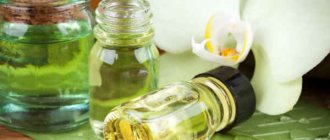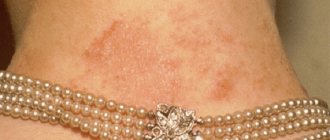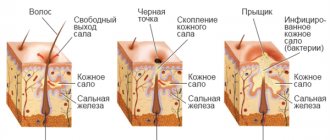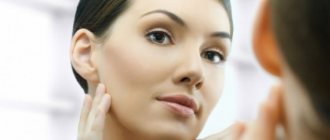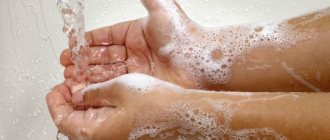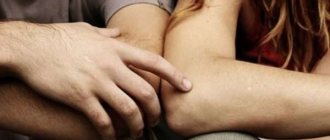The process of formation of ulcers
The fat that the sebaceous gland produces in excess amounts clogs the sebaceous ducts. The result is a painful, purulent pimple. Most often this occurs in the chest area, on the head, face, back, buttocks and intimate areas, in places where profuse sweating occurs. Negligent treatment of skin rashes leads to aggravation of the inflammatory process, which is why scars and cicatrices remain on the skin.
The appearance of purulent acne in the face area
The face is the most common area where ulcers are affected. First, a small bump appears on the skin with reddened skin around it. The inflamed area begins to ripen, hurt and itch, increasing in size. The abscess becomes more noticeable. The focus of its inflammation is called a core neoplasm with a yellow-white tint.
Attention! Abscesses on the face are one of the indicators of a teenager entering adolescence, when the body matures, accompanied by a hormonal surge, so during this period you should carefully care for the surface of the skin.
Purulent plugs in different forms of sore throat
Catarrhal tonsillitis is more common than other tonsillitis. It has a relatively mild course. Follicular tonsillitis is severe. Inflammation develops in the mucous membrane of the tonsils and its deeper layers. With catarrhal and follicular tonsillitis, tonsilloliths do not form.
Rice. 6. The photo shows acute catarrhal tonsillitis. There is hyperemia in the area of the lateral ridges and larynx. The tonsils are swollen, without purulent plugs or plaque.
Lacunar tonsillitis
Lacunar (purulent tonsillitis) occurs with inflammation, which is associated with the effect of pyogenic bacteria and neutrophils, leukocytes and lymphocytes opposing them on the tonsil tissue. Streptococci play the main role in the development of lacunar tonsillitis. The defeat is always two-sided. Sometimes the patient may have signs of both lacunar and follicular tonsillitis.
As a result of inflammation, the surface of the tonsils becomes hyperemic. Pus accumulates in the gaps. If there is a large amount of pus, you can notice how it flows out of the lacunae. On the surface of the tonsils, the pus merges in places and forms light yellow plaques. Plaques can be easily removed with a spatula. The underlying layer is not damaged. Purulent plugs are separate yellowish formations that are located at the mouths of the lacunae. Their composition is identical to that of pus.
Rice. 7. The photo shows lacunar tonsillitis.
Quinsy
Phlegmonous tonsillitis develops in individuals with chronic tonsillitis. Initially, lacunar tonsillitis develops. Pus and tonsilloliths form in the lacunae. Next, the inflammatory process moves from the lymphoid tissue to the peri-almond tissue. The focus of inflammation in the peri-almond tissue displaces the tonsil in the opposite direction. Against the background of severe hyperemia, significant swelling of the soft palate is noted. A putrid odor appears from the mouth. Lymph nodes are enlarged and sharply painful.
Rice. 8. Inflammatory focus in the peri-almond tissue on the right. Pus and purulent plugs in the tonsils are visible.
Chronic tonsillitis
Chronic tonsillitis develops as a result of constant inflammation of the tonsils. Initially, the inflammatory process is localized only in the lacunae of the palatine tonsils. Further, as a result of constant exacerbations, the inflammatory process invades the lymphoid tissue. Over time, inflammation during exacerbations develops only in the lymphoid tissue, where connective tissue gradually develops. The tonsils increase in size and become loose, sometimes becoming denser due to the abundant proliferation of connective tissue.
Purulent plugs in the tonsils are the main symptom of chronic tonsillitis.
Rice. 9. The photo shows purulent plugs in the tonsils with chronic tonsillitis. The proliferation of connective tissue has changed the normal appearance of the oropharynx.
For details, see the article “Chronic tonsillitis and its treatment.”
Why does a pustular pimple appear?
There are several factors that contribute to the appearance of acne:
- Disturbed hormonal balance. The period of menopause, pregnancy or menopause is characterized by changes in hormonal levels, so purulent acne in women appears in the face, neck, chest or back.
- Unhealthy food. Diseases of the gastrointestinal tract, liver, alcohol abuse, and fatty foods are the result of poor nutrition. As a result, metabolic processes are disrupted.
- Transitional age. Acne is typical for adolescents during puberty, when hormonal imbalances are a consequence of changes in the body. Hormones become hyperactive, changing the body of girls and boys.
- Development of hyperkeratosis. This is the rapid division of skin cells, so they quickly become horny and flake, clogging the pores. The accumulation of subcutaneous fat in these places leads to the appearance of purulent bacteria. Hyperkeratosis is a pathological process due to impaired blood supply, as well as a lack of vitamins in the body.
- Consequences of improper extrusion. Dermatologists and cosmetologists do not advise squeezing out purulent pimples on your own, citing the possibility of worsening the inflammatory process, after which scars remain on the skin.
- Stressful situations. Stress reduces the body's protective functions, so its resistance to the effects of bacteria with frequent nervous breakdowns and depression is significantly reduced.
- Poor quality cosmetics. Cosmetics that do not suit the skin and are expired are an excellent provocateur for the occurrence of ulcers.
- Steroid drugs or antibiotics.
- Lack of proper skin care. Insufficient cleansing of the skin or neglect of existing ulcers.
Measures to prevent ulcers
In light of the fact that the causes of pustules on the skin are quite diverse, it will be difficult to offer universal methods. But some preventive measures will still not be superfluous and will significantly reduce the likelihood of purulent acne breaking out.
These include:
- proper skin care, especially during the period when the body undergoes hormonal changes,
- regular walks in the air,
- balanced diet,
- abstaining from bad habits such as smoking, alcohol abuse, drug use, etc.
Types of purulent acne
A papule is an infected acne pimple, which is characterized by painful sensations and the presence of a small reddish bump. Pus is not visible to the naked eye. Scars do not remain after they disappear.
Important! If papules appear multiple times, you should consult a doctor, as this may be evidence of the development of horny eczema, amyloidosis, psoriasis, syphilis and other diseases in the body.
A pustule is a severe form of papule. It looks like a rounded-superficial or deep tubercle filled with pus. A deep pustule forms an ulcer, which eventually becomes covered with a crust. After it falls off, a scar remains at the site of the pimple. The skin around the lesion is inflamed, which is why it is red. The form of pustules is:
- hemispherical;
- cone-shaped;
- flat;
- spherical.
A follicular abscess of staphylococcal nature affects the hair column and is of streptococcal nature.
- A nodule is a papule, the size of which exceeds one centimeter. The deep layer of the skin is affected, so the pain is pronounced. A healed nodule leaves a pigment spot, atrophic or keloid scar of a large size.
- Cyst - formed in a severe form of purulent pimple, which consists of several blackheads filled with pus and processed sebum. The cysts form a chain connected by the fistula duct. A cystic conglomerate is characterized by a bluish tint, is difficult to treat, and also leaves deep scars on the skin when healing.
Degree of disease with purulent acne
- Small comedones, smoothly turning into papules (rarely into pustules), covering small areas of the skin.
- Increased area of rashes compared to the first degree.
- A large number of pronounced pustules, papules and comedones. The skin is itchy. Healed purulent formations leave marks.
- Stage requiring medical treatment. Bluish bumps, the size of which exceeds five millimeters. After healing, scars and scars remain.
Treatment
Removing acne on your own can lead to inflammation rather than cure it. Treatment of ulcers requires an integrated approach.
It is recommended to begin therapy by getting rid of the purulent rash. Then the root causes are eliminated, and the body’s metabolic processes are normalized.
The first rule is to contact a specialist in a timely manner. Modern treatment methods in beauty salons make it possible to do this.
Treatment options
- Liquid nitrogen – freezing of pustular rashes, their destruction. Cryotherapy is the basis of this method.
- Distilled water – ozone therapy technology.
- Ultrasound – deep cleaning and removal of dead cells.
- Chemical peeling – allows you to remove dead skin cells.
- Mechanical cleansing is preventative skin care.
- Mesotherapy allows you to individually select effective medications for each skin type, taking into account the degree of disease progression.
Traditional medicine in the treatment of pustular acne
In order to cure this disease, there are many recipes from natural plants. These are decoctions, ointments and other compositions prepared mainly for cleansing and restoring the skin.
The properties of the plant are used to heal the surface of the skin. The treatment is characterized by simplicity, ease and relative cheapness.
Remove all needles from one aloe leaf and cut it in half. The resulting pulp is applied to the purulent wound and secured with a plaster. The procedure is carried out before bedtime, in the evening.
Advice! It is recommended to use a bactericidal patch. An open wound increases the possibility of infection. Its drainage effect will help remove the purulent contents of the wound.
Medicines
If there are reasons that do not allow you to use traditional medicine, you can use medical ointments:
- ichthyol ointment;
- Vishnevsky ointment.
These drugs have an antiseptic effect, kill the carrier of the infection, and remove the purulent contents of the pimple out. In addition, after cleansing the wound, it heals faster, since the action of the ointments promotes the regeneration of the dermis. Before each application of a fresh layer of ointment, the affected area should be cleaned.
Important! The use of medications or folk remedies to cleanse the skin significantly accelerates the healing process of purulent wounds, and timely preventive skin care completely eliminates relapses of inflammatory processes.
Pimples filled with purulent fluid are one of the most common problems found on human skin. This is not only a cosmetic, but also a physical defect that must be treated. Ulcers on the face can appear for a variety of reasons. The method of therapy directly depends on this.
Features of the disease
Purulent pimples appear as a result of the accumulation of subcutaneous sebum in the pores. Due to certain factors, the secretion of the sebaceous glands cannot come out, which ultimately leads to the development of an inflammatory process. This type of acne is one of the most dangerous, as it can cause infection of healthy pores and spread of the disease to the entire face.
It has been proven that this disease most often affects people whose skin is too oily, but pustules can also appear in those who have relatively dry skin. As a rule, they arise unexpectedly and at the most inopportune moment. Initially, the presence of a small reddish bump is noted; the skin around it has a higher temperature and swells slightly.
Over time, the infectious process continues to develop, causing acne to turn into full-fledged ulcers.
Outwardly, they look like round vesicles, in the center of which there is a rod filled with purulent content.
In addition to a completely unaesthetic appearance, such formations provoke significant pain. The pain goes away only after the abscess opens, the contents are removed, and the resulting wound is completely healed.
Small pustules on the face can be removed mechanically, that is, by squeezing them out. However, it is not recommended to do this at home, since there is a high risk that it will not be possible to completely remove the pus, which is why the infection can spread to neighboring pores. As a result, instead of one small pimple, a person will get several at once, and much larger ones. Incorrect squeezing technique often provokes the development of boils.
But the accumulation of subcutaneous fat is only a consequence. But there are a lot of reasons that can provoke this pathological condition, and each of them should be studied in detail.
Pyoderma in adults and children
Pustular skin diseases are primary and secondary.
Pustular skin diseases are a large group of diseases caused by staphylococci, streptococci or mixed flora.
The prevalence of this pathology is very high.
Almost every person experiences pyoderma during their lifetime. The following structures are affected:
- epidermis;
- dermis;
- nails;
- hair;
- sebaceous glands;
- sweat glands.
The infection can spread to joints and bones. In severe cases, microbes enter the bloodstream and disrupt the function of internal organs.
Pyoderma in children and adults can be primary or secondary. In the first case, it develops independently. The secondary form can be a complication of other diseases: scabies, diabetes, eczema.
There are staphyloderma, streptoderma and streptostaphyloderma.
Infection may spread to joints and bones
The most common pustular diseases are:
- furuncle;
- furunculosis;
- carbuncle;
- folliculitis;
- vesiculopustulosis;
- hidradenitis;
- sycosis;
- ostiofolliculitis;
- pseudofurunculosis;
- streptococcal impetigo;
- lichen simplex;
- jam;
- ecthyma;
- cellulite;
- paronychia;
- erysipelas;
- mixed form of impetigo;
- ulcerative-vegetative chronic pyoderma;
- cicatricial folliculitis.
The greatest danger is posed by deep pyoderma.
Causative agents of pustular diseases
In children and adults, pyoderma is caused by staphylococci and streptococci. They are representatives of the natural human microflora. Their habitat is the skin. Most staphylococci and streptococci belong to opportunistic microflora, but some of them are pathogenic.
Staphylococci produce toxins
Staphylococci play a major role in the development of pyoderma. These bacteria have the following distinctive features:
- are normal inhabitants of the skin;
- found in large quantities under the nails and in the folds of the skin;
- represented by 20 species;
- unable to move;
- spherical shape;
- undemanding to the nutrient medium;
- can cause allergic reactions;
- have different pathogenicity factors.
Staphylococci produce toxins (sphingomyelinase, alpha toxin and exfoliative toxin). Other pathogenicity factors of these bacteria are adhesins, protein A, enzymes and capsule. All of them help microbes maintain their numbers, penetrate the skin and survive under unfavorable environmental conditions.
Streptococci in children and adults have a spherical shape. They are arranged in the form of chains. Streptococci produce toxins, enzymes and protein M. These bacteria are isolated in every tenth patient with pyoderma. They are very stable in the environment. Streptococci can withstand low temperatures.
Causes of pustules on the face
- Age-related changes
Perhaps the most common reason. Almost every teenager has acne. All this is due to natural changes in the body that occur during puberty. The fact is that during puberty, hormones are significantly activated. Their increased production causes not only the appearance of secondary sexual characteristics in boys and girls, but also the appearance of purulent rashes on the face.
A fairly common childhood disease, which manifests itself especially actively during puberty. This disease is expressed in the accelerated division of epidermal cells, due to which the body does not have time to get rid of dead tissue. This results in an accumulation of dead skin, which clogs the pores. It’s easy to guess that this is an ideal environment for the development of all kinds of infections and, accordingly, the appearance of purulent acne.
The skin reacts very sensitively to various pathologies of internal organs. Abuse of alcohol, fatty, spicy and salty foods, smoking, etc. contribute not only to dysfunction of the gastrointestinal tract, liver and kidneys, but also manifests itself in the appearance of significant acne on the face, including purulent ones.
- Hormonal imbalance
This reason is considered from the point of view of adults. For example, this is relevant for pregnant women or during menstruation. The same applies to menopause. During these periods, the formation of white pustules on the face is more active.
Not all cosmetics are easily tolerated by the skin. Sometimes they can cause the development of inflammatory processes, which result in the appearance of ulcers. This is relevant for such cases as using low-quality cosmetics, touching the face with dirty hands, for example, when applying foundation, or using other people's cosmetics.
Everything is very simple here - stressful situations provoke a decrease in the body’s defense mechanisms. The immune system weakens, making it much worse at fighting various infections, viruses and bacteria. Against this background, the risk of developing inflammatory processes significantly increases. As a result, the skin of the face becomes covered with unpleasant white ulcers.
You need to take care of your facial skin constantly and efficiently. It must be clean; using special cleaning products seems to be a good option. A person’s inaction when acne appears can also aggravate the problem - as mentioned above, they must be treated.
Hormonal drugs provoke a deterioration in the condition of the skin, as the hormonal balance changes. These drugs include steroids and antibiotics. Skin problems are especially common among professional athletes.
If you do not understand the technique of mechanical removal of ulcers, there is no point in touching them at all. Improper squeezing is guaranteed to make the problem worse. Even if it was possible to get rid of all the purulent contents, tissue damage can leave a mark in the form of a scar. The larger the abscess, the more noticeable the scar.
Causes of ulcers
The appearance of pustules on the skin usually indicates processes in the body such as:
- infection. Most often, in such cases, purulent pimples indicate skin damage by Staphyloccus aureus, which can be brought in both from the external environment (for example, through scratches) and from other affected components of the body through the blood,
- metabolic disorders associated with diseases such as diabetes, vitamin deficiency, anemia, thyroid disease, etc.,
- hormonal changes in the body during puberty, pregnancy, before menstruation,
- the presence of chronic diseases (such as tonsillitis),
- excessive secretion of sebum during puberty in adolescents (teenage acne, or sebaceous plugs),
- excessive use of antibiotics or steroid-containing drugs,
- intoxication of the body,
- allergy,
- stress, nervous experiences,
- frequent overheating or, conversely, hypothermia,
- use of low-quality cosmetics,
- insufficient skin care.
Proper treatment of pustules - prevention
The effectiveness of treatment directly depends on how well the cause of their appearance was determined. In the early stages of the disease, especially during puberty, following simple recommendations will help. They also act as preventive measures.
Girls definitely need to reconsider all the cosmetics they have. It is strongly recommended to remove questionable products. The same applies to other people's brushes and other devices. Please note that a rash may appear after using a specific product. The cosmetics set should include a cleansing and drying tonic, a zinc-based mask and a scrub.
Avoid touching your face with bare hands. Even if the palms or fingers are visually completely clean, they still contain millions (!) of different bacteria that can trigger the process of formation of purulent acne. You need to wash your face at least twice a day. If you have been outdoors or work in a contaminated workplace, the number of washings needs to be increased. During hygiene procedures, it is advisable to use the above cosmetics. This is equally true for both women and the stronger sex.
Try not to get nervous over trifles. You need to live calmly and measuredly. It is very important to exclude from everyday life any provoking factors that contribute to hassle, from jostling on public transport in the morning to quarrels with your husband.
Treatment with medications and procedures
If small pustules on the face continue to appear, despite all preventive measures, and, moreover, their number and complexity are growing, you should seek help from specialized specialists, in particular, a dermatologist.
What is the treatment for purulent acne:
- First of all, the patient undergoes a test that will help identify the presence of an infectious lesion in the body. It is on the basis of the results obtained that the course of treatment is prescribed;
- One type of therapy is antibacterial or antibiotic drugs of systemic action, that is, tablets and capsules. Antibiotics are relevant for complex types of disease. The duration of the course of therapy is an individual parameter. As a rule, it ranges from one week to six months in the most advanced cases;
- Local antimicrobial and antibacterial agents – ointments, creams, gels, etc. – help effectively get rid of purulent acne. Although they can be purchased at pharmacies without a prescription and at an affordable price, it is strongly recommended that you first consult with your doctor. The most common drugs in this group are Levomekol, Metrogyl, Zinc-gel and Zinerit;
- corticosteroid drugs are prescribed exclusively by a doctor. These are very strong medications that have a significant effect on the human body. They are used in cases where the causes of ulcers on the face lie in hormonal disorders;
- if problems with the gastrointestinal tract have led to the formation of unsightly pustules, then special attention needs to be paid to diet. A balanced diet must include fresh and low-fat foods. It is recommended to consume active biological additives, brewer's yeast and other substances that promote the breakdown and removal of fat cells from the body. But fatty foods, smoked foods, pickles, flour, alcohol, coffee, cigarettes - that is, everything that you love so much is strictly contraindicated.
Causes
There are many reasons for the occurrence of acne on the face, but the mechanism of the appearance of an abscess is the accumulation of subcutaneous sebum in the pores. This fat cannot come out for certain reasons and begins to become inflamed, thereby forming a red bump on the surface of the skin. At this stage, a person can squeeze it out, or he can wait for the rod to mature.
It is important to know! If the pus from a pimple is not completely squeezed out, the residue may cause the abscess to grow larger than it was, and the infection may spread to nearby pores. There is a high probability that several more will appear next to the squeezed pimple.
But still, why do purulent acne appear on the face? The reasons for their occurrence are described below.
- Age . Girls and boys of school age are often susceptible to acne and all other types of pimples. This period is called puberty. As you grow older and your body changes during adolescence, hormonal imbalances are common. The hyperactivity of hormones changes the body of a child into the body of an adult: boys’ voices become rougher and erections appear, while girls’ breasts begin to grow, menstruation appears and, as a result, acne appears.
- Hormonal imbalance in women during menstruation or its absence, pregnancy or menopause leads to the appearance of purulent acne on the face, neck, back or chest.
- Poor nutrition and, as a result, problems with the gastrointestinal tract can cause problematic facial skin. This item includes liver problems due to alcohol abuse, fatty foods, etc.
- Hyperkeratosis is a pathology characterized by the rapid division of skin cells, subsequently causing their rapid keratinization and exfoliation. The skin of the face becomes covered with red bumps, where subcutaneous fat accumulates under them in the pores. The pores are clogged with particles of dead cells and bacteria and then pus begin to appear in the accumulated fat. The causes of hyperkeratosis are pathologies of the body, impaired blood supply to certain parts of the body, lack or excess of vitamins.
- Ungroomed facial skin . Lack of cleansing of the skin or inaction when acne occurs leads to a worsening of the problem.
- Squeezing out ulcers . Not a single doctor advises squeezing ulcers, no matter how terrible they may seem. Improper extrusion makes the problem worse. If there is no pus left inside after squeezing out, and the wound after the pimple has healed in a few days, a scar will still remain, which is much more difficult to get rid of.
- Nerves and stressful situations. The more stressful situations every day, the more the body’s immunity to different types of bacteria decreases. The skin stops coping with inflammation and as a result, an abscess appears.
- Using inappropriate cosmetics leads to inflammatory processes. This also includes touching your face with dirty hands, using other people's cosmetics or special makeup brushes.
- Taking steroid drugs or antibiotics. Athletes who take steroids often experience skin problems.
Frequent use of antibiotics leads to the appearance of medicinal acne.
Whatever the cause of acne, measures should be taken immediately. To know how to properly get rid of pimples, you need to understand what types there are.
Types of purulent acne
Depending on the time of maturation and shape, several types of acne are distinguished.
- Comedon . It appears as soon as the pore is clogged with a sebaceous plug. Can be closed or open. Cutaneous - open, easily removed, it contains liquid and is black in color. In other words, it's an eel. The closed one is formed under the skin and is visible to us as a white ball. This is a wen or white purulent pimple.
- If an infection somehow gets into the comedone, then a papule . This is a fully formed pimple, it feels painful when pressed, and the color varies from red to purple. No pus is visible
- A papule may develop into a pustule , a more severe form. But it doesn't always appear this way. It can be primary, and they are popularly known as “red pimples.” The difference from a papule is that a white dot appears on the red tubercle.
- Nodular cystic acne is a severe form of pustules. They are interconnected by fistulous ducts and form conglomerates. Accompanied by painful sensations over the entire surface of the skin with acne. They require immediate treatment, as they leave huge scars.
- The most severe form of acne is fulminant acne . They are accompanied by muscle and bone pain and tend to change the leukocyte form of the blood. With this type of rash, acne affects large areas of the skin and requires urgent medical intervention.
What are purulent plugs? Reasons for education
Tonsilloliths are formed in the tonsils and are small formations that accumulate in the lacunae (depressions) of the organ during tonsillitis and chronic tonsillitis. Their formation begins in the lacunae, where leukocytes and neutrophils begin to fight pathogenic, pyogenic microbes. In the lumens of the lacunae, desquamated epithelium, leukocytes, microbes and their decomposition products, protein masses and mucus accumulate. This is how pus is formed. At the beginning of the disease, pus pours onto the surface of the tonsils. But soon the pus thickens and takes the form of films that are easily removed with a spatula.
Caseous plugs are separate yellowish formations that are located at the mouths of the lacunae. Their composition is identical to that of pus. Due to the deposition of minerals (including calcium salts), purulent areas become denser. A similar picture often occurs with chronic tonsillitis and is a reason to immediately seek medical help.
Traffic jams sometimes form in healthy people. They are dense and do not cause bad breath. Due to the organ’s ability to self-cleanse, treatment is not required in this case.
Pus and purulent plugs in the tonsils are often the cause of unpleasant putrid odor from the mouth
Rice. 4. The photo shows purulent plugs in the tonsils.
Rice. 5. The photo shows purulent plugs extracted from the lacunae of the tonsils.
How to get rid of it?
- To get rid of ulcers on the face, you should immediately determine the cause. Girls need to review their cosmetics for compatibility with their skin type and expiration date, and exclude other people's cosmetics from use. It may be worth purchasing a drying toner and a cleansing facial scrub. A zinc-based mask would also be useful.
- It’s worth starting to control yourself about touching your face with your hands. Even if dirt is clearly invisible on the palms, bacteria are still present and, when they get on areas of the skin with acne, they aggravate the situation.
- You need to wash your face at least 2 times a day – morning and evening. It is better to use the above mentioned products to cleanse and tone the skin. Using a cream with a light texture will also not hurt both women and men.
- As previously found out, hassle has a detrimental effect on the condition of the skin. In this case, you should think about your daily life and try to eliminate or minimize irritating factors.
The above remedies can help during puberty or with the first degree of severity of the disease. If there are no visible improvements, you should immediately consult a doctor . Treatment by a dermatologist may cost a little more than using folk remedies, but it will still be more effective.
First of all, you need to get tested for infections . Depending on the result, treatment may include antibiotics and antibacterial agents in the form of tablets for oral administration. It also depends on the severity of the disease. The course of treatment can last from 1 week to 6 months or longer.
Be careful! Self-medication can harm your health! You should not take antibiotics or antimicrobials without consulting your dermatologist or other doctors. The components of these drugs can adversely affect internal organs.
Antibacterial, antimicrobial ointments , gels and lotions are widely used in the treatment of purulent acne You can purchase them at the pharmacy yourself or consult a doctor to select the right product. An effective ointment for purulent acne on the face - Levomekol. Zinerit lotion, Zinc gel, Skinoren gel, Metrogyl gel, etc. are popular.
If the cause of the ulcers turns out to be a hormonal imbalance, in this case drugs that contain corticosteroids are used. They are prescribed both in tablets and as an ointment. For example, Hydrocortisone ointment, etc.
As is already known, ulcers still arise due to problems with the gastrointestinal tract . In this case, you should adhere to a diet: exclude fatty foods, alcohol, cigarettes, smoked foods from the daily diet and eat less flour. Eat only fresh and low-fat foods. To this you can add combined dietary supplements, brewer's yeast, Lactrofiltrum to the diet, that is, drugs that bind and remove fats from the body.
The above drugs are prescribed by a dermatologist after passing certain tests, and, as a result, the treatment is always effective. But, there is also the option of visiting a cosmetologist . Beauty salons provide services:
- Laser treatment of purulent acne.
- Phototherapy of acne.
- Peeling.
- Mechanical facial cleansing.
- Mesotherapy.
- Ozone therapy.
- Cryotherapy.
The cost of a cosmetologist's services is much higher than a visit to a dermatologist. There may be several procedures to get rid of acne, depending on the severity of the acne disease, and all of them are paid.
Something to remember! In beauty salons, you should contact trusted professionals who have the appropriate qualifications and documents confirming them.
How to diagnose inflammation?
As soon as you feel a deterioration in your condition or notice an unusual formation on the skin, immediately consult a doctor. If the abscess is located on the surface, diagnosis will not be difficult. But to ensure the accuracy of the diagnosis, the doctor must prescribe additional examinations. The specialist collects anamnesis, learns about the patient’s well-being and issues referrals for general clinical tests.
If an inflammatory process in the lungs or brain is suspected, a computed tomography scan is prescribed. To diagnose a gastrointestinal abscess, ultrasound is most often prescribed. The doctor may also require a puncture (diagnostic puncture) followed by fluid collection for examination.
Treatment with folk remedies
There are really effective remedies for purulent acne that have been used for decades. Among these remedies there are also medications, but doctors have stopped prescribing them for one reason or another.
- Remedy for purulent acne on the face No. 1 - aloe . Alcohol tincture or using fresh aloe juice is good for treating purulent acne. This is because the leaves of the plant contain bactericidal properties. Four-year-old plants help better in treatment. To prepare the tincture you need to take aloe leaves and 70% alcohol (at least vodka) in a ratio of 1:5. The leaves should rest in a cool place for 10-15 days. Next, grind the aloe in any convenient way, add alcohol and leave for another 10 days in a cold place. The tincture is ready for use. Another option is to use aloe. Take a leaf and divide it lengthwise into two parts so that there is pulp on one side. Next, you can do it in two ways: • Rub your face with the side of the aloe with the pulp and, without wiping, let it absorb for 2 minutes. Do this at night for several weeks in a row until the acne goes away. Cut a small piece of aloe from the leaf. • Cut it so that the flesh is visible. Take a breathable patch and stick it to the pulp side of the aloe vera to the pimple. The procedure is done at night.
- Iodine is applied to the pimple at night. It has a drying effect and relieves internal inflammation. The course of treatment is up to 7 days. You need to apply a cotton swab with iodine to the pimple. The downside is that small yellow spots remain. They are not easy to hide. This treatment option is suitable for people without allergic reactions to iodine.
- Vishnevsky ointment or ichthyol ointment is widely used in the treatment of large boils, pustules, nodular cystic acne. They have a pus-pulling effect. The course of treatment is up to 5 days, depending on the pimple. You need to make a small pad out of a bandage, apply one of the ointments to it, apply it to the pimple and secure it with a band-aid. Leave overnight. The downside of this treatment is the smell.
How to treat?
Any pimples on the body, especially purulent ones, need to be removed as soon as possible. But in order to get rid of the problem as quickly as possible, you should consult a doctor and follow all his instructions. An individual plan is drawn up for each patient, taking into account the nature of the pathology and the characteristics of the body.
Traditional treatment
Milia on the face of newborns does not require treatment, as they disappear on their own. It is recommended to carry out normal hygiene procedures; you should not pierce or squeeze out white pimples. It is also prohibited to remove other pustules on the face yourself, so as not to provoke the spread of infection and the development of dangerous complications.
Medicines play a major role in the treatment of purulent acne. With the help of drugs, it is possible to kill the pathogen, reduce the activity of the inflammatory process, clean the wound and speed up healing. The following drugs may be present in external therapy regimens:
- Antiseptics (salicylic alcohol, brilliant green, potassium permanganate, fucorcin, iodine solution).
- Antibacterial (chloramphenicol, erythromycin ointment, Levomekol, Dioxyzol, Gentaxan, Chlorophyllipt).
- Antifungals (Lamisil, Exoderil, clotrimazole).
If these remedies are sufficient for superficial pyoderma, then deep and widespread processes require systemic therapy with antibiotics (penicillins, cephalosporins, aminoglycosides), immunomodulators (antistaphylococcal plasma, gamma globulin), and detoxification agents. Microsporia requires the prescription of griseofulvin; scrofuloderma is treated with antituberculosis drugs.
In the complex treatment of recurrent pyoderma, physiotherapeutic methods are used - UV irradiation, UHF, electro- and phonophoresis, laser therapy. Large abscesses are opened surgically, washed with antiseptic solutions and bandaged with antibacterial ointments until complete healing.
Folk remedies
Alternative medicine offers a lot of ways to treat pustular processes on the skin. To get rid of inflammatory elements, you can use the following recipes:
- Sage leaves, mint, chamomile flowers (1 tbsp each) - pour 4 cups of boiling water, leave for 30 minutes, use to treat acne and folliculitis.
- Seed grass and horsetail, calendula and rose hip flowers, blackberry leaves, oak bark (in a 1:1 ratio) – 1 tbsp. l. the mixture is boiled in 1 glass of hot water for 10 minutes, then infused for 2 hours, the broth is used for lotions.
- Cornea herb (1 tsp), petroleum jelly and lanolin (10 g each), lard (3 tbsp) - lubricate inflamed areas.
- Fresh potato and dandelion juice - for wiping the skin.
- Apply a baked onion, grated beet pulp, a clove of garlic boiled in milk, chopped celery leaves to the affected areas.
- Flatbreads made from flour and honey, peas and beans - used in the form of applications.
It is also recommended to take baths with the addition of potassium permanganate, decoctions of chamomile flowers, celandine herb or medicinal cap, and walnut leaves. To increase the body's defenses, it is suggested to take the following drugs orally:
- Honey, butter, lard, cocoa (100 g each), aloe juice (1 tbsp.) – take 1 tbsp. l. in a glass of milk 2 times a day.
- Chopped walnuts (0.5 kg), honey (300 g), aloe juice (100 ml) - use 1 tbsp. l. three times a day half an hour before meals.
- Rose hips and raspberries, black currant and lingonberry leaves (in equal proportions) - 1 tbsp. l. pour two glasses of boiling water and leave in a thermos for an hour, add 2 tbsp. l. honey and take ½ cup twice a day.
When intending to use traditional medicine, one should take into account their lack of proven effectiveness. In addition, allergies may occur to many ingredients, which will only aggravate the patient’s condition.
Any medications and alternative remedies can be taken only after consulting your doctor. Self-medication is strictly not recommended.
Purulent acne on the skin can appear for various reasons, among which there are quite serious conditions with a risk of complications. Only based on the results of diagnostics with the participation of a doctor can we say what caused the rashes and how to get rid of them.

